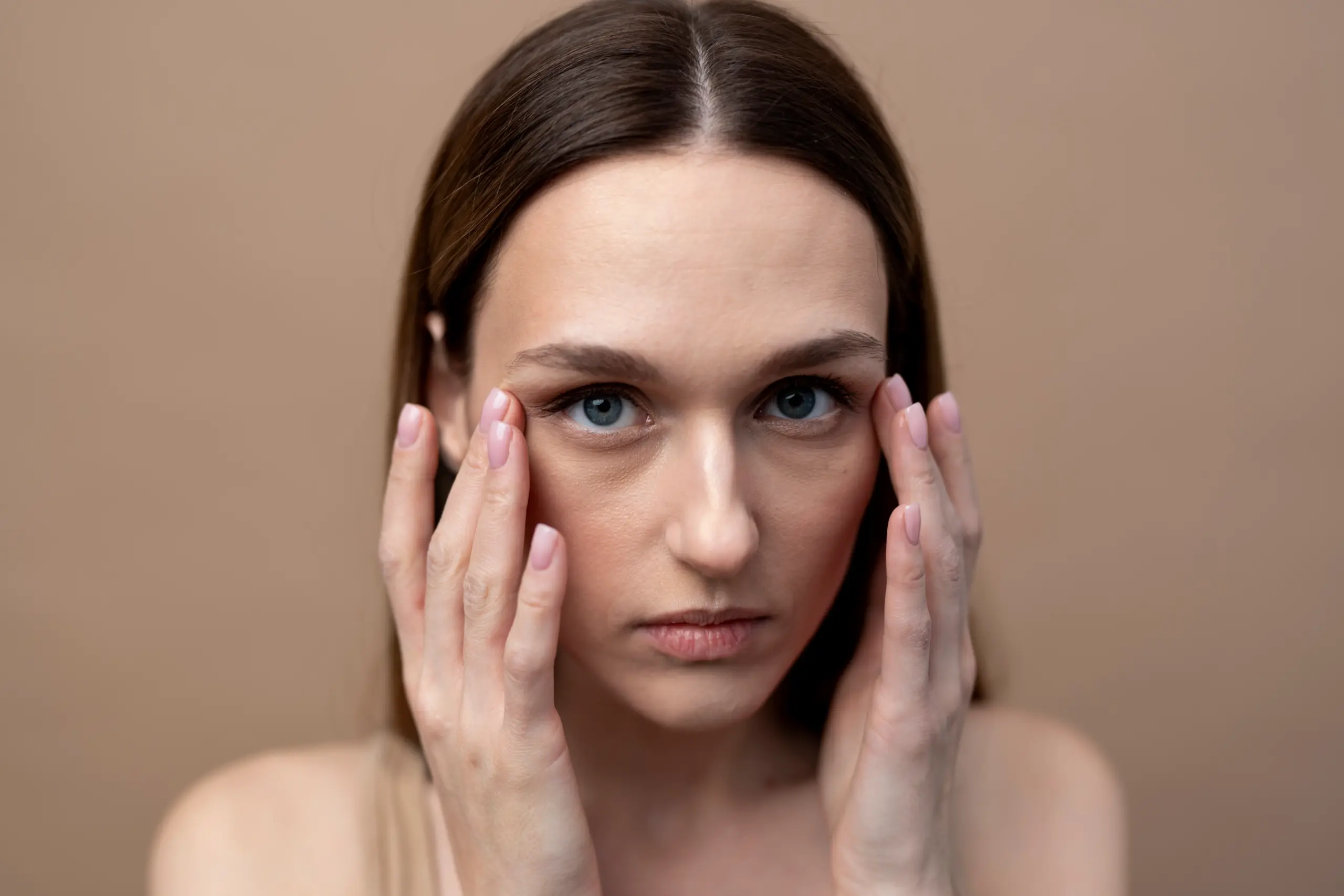There are many effective ways to get rid of puffiness and tired-looking eyes for good, from at-home remedies that reduce swelling to advanced medical and surgical treatments (such as lower blepharoplasty) that offer lasting results.
Many people struggle with under-eye bags that make them look exhausted even when they feel fine. Understanding what causes them is the first step toward choosing the right treatment and restoring a fresher, more awake appearance.
What causes bags under the eyes?
Before we talk about solutions, it’s helpful to know what you’re up against. Those under-eye bags aren’t all the same, and their cause dictates the best treatment.
Genetics: Often, the tendency is inherited. If your parents had prominent eye bags, you’re more likely to develop them too.
Ageing & Skin Laxity: As we get older, the delicate skin around our eyes loses collagen and elasticity. At the same time, the supportive muscles weaken.
Fat Pad Prolapse: This is a key player. The thin membrane that holds the natural fat cushion in place beneath your eye can weaken, allowing the fat to bulge forward and create that classic “bag” appearance.
Fluid Retention: This is what causes temporary morning puffiness. Gravity causes fluid to pool in the under-eye area overnight.
Allergies: Histamine release from allergies can cause inflammation, swelling, and fluid retention, making under-eye circles and puffiness more pronounced.
Lifestyle Factors: A salty meal, one too many glasses of wine, or a poor night’s sleep can all exacerbate fluid retention and make bags look more prominent the next day.
What is the best way to remove bags under your eyes for good?
Before considering surgery, there are several non-surgical alternatives for puffiness that can temporarily improve the appearance of under-eye bags. Treatments such as fillers, radiofrequency tightening, or plasma fibroblast therapy can smooth and firm the area with minimal downtime.
However, the only definitive and permanent solution for true eye bags is a surgical eye bag removal known as lower blepharoplasty. This procedure directly addresses the root cause, and a key decision your surgeon will make is what to do with the protruding fat (remove it or reposition it).
- Fat Removal: This is the traditional and still very effective approach. The surgeon carefully removes the excess fat pads that are creating the bulge. This is ideal for younger patients with good skin elasticity and a clear “bag” without a deep hollow beneath it.
- Fat Repositioning: This is a more advanced technique that often produces a more rejuvenated result for the right candidate. Instead of removing the fat, the surgeon carefully releases it and then re-drapes it down to fill the deep groove (the tear trough) that often develops between the lower eyelid and the cheek.
The surgical approach itself also varies:
- Transconjunctival Blepharoplasty: The surgeon makes a tiny incision inside the lower eyelid. This allows them to remove or reposition the protruding fat pads without any visible external scar. It’s ideal for patients who don’t need excess skin removed.
- Transcutaneous Blepharoplasty: An incision is made just below the lash line. This approach allows for the removal of both fat and excess sagging skin, providing a smoother, more rejuvenated contour.
Recovery typically involves 1-2 weeks of noticeable swelling and bruising, with final, natural-looking results becoming apparent over several weeks to months.
Learn More about the different techniques in our detailed guide.
Tips for Removing Eye Bags Naturally
If you’re looking for how to remove puffy bags under your eyes caused by temporary factors, you have several effective options. It’s important to note that these methods can significantly improve the appearance of puffiness and swelling, however, if your main concern is prolapsed fat pads or significant skin laxity, the only permanent solution is a lower blepharoplasty procedure.
- Sleep & Elevation: Aim for 7-9 hours of quality sleep. Try using an extra pillow to elevate your head, which helps prevent fluid from accumulating overnight.
- Watch Your Intake: Reduce your sodium and alcohol consumption, especially in the evenings, as both can lead to fluid retention.
- Cold Compresses: Applying a cold spoon, chilled cucumber slices, or a cool damp cloth for 5-10 minutes in the morning can constrict blood vessels and reduce temporary puffiness.
- Allergy Management: If allergies are the culprit, an over-the-counter antihistamine can help reduce the swelling.
- Topical Creams: Eye creams containing caffeine can temporarily tighten the skin, while retinol can, over time, thicken the skin and improve collagen. Sunscreen is non-negotiable to prevent further skin damage and thinning.
- Gentle Massage: Using your ring finger to gently massage the area from the inner corner outwards can encourage lymphatic drainage and move stagnant fluid.
Frequently Asked Questions (FAQs)
Unfortunately, the answer is no. If the primary cause is a prolapsed fat pad, non-surgical eye bag treatments like creams or lasers can only improve the skin’s quality or reduce puffiness, they cannot remove or reposition the fat. For a permanent solution, lower blepharoplasty is the only proven method.
Applying ice or a cold compress can temporarily constrict blood vessels, reducing swelling and fluid retention under the eyes. It’s an effective short-term remedy for mild puffiness due to fatigue or allergies, but it does not eliminate true eye bags.
The most common cause of eye bags is fat herniation, where the fat that cushions the eyeball pushes forward through weakened lower eyelid tissues with age. Other contributing factors include genetics, fluid retention, lack of sleep, allergies, and skin laxity. Over time, these factors combine to create puffiness, dark shadows, and sagging under the eyes that often persist despite lifestyle changes.
This depends on your anatomy. Fillers are brilliant for filling hollow tear troughs that create shadows. However, if you have a true protrusion of fat bags, adding filler above them can sometimes make the area look more puffy. A consultation is essential to determine the best approach for how to remove bags from under your eyes in your specific case.
Most people plan for 7-10 days off work. You’ll need to apply cold compresses initially, sleep propped up, and avoid strenuous activity. Swelling and bruising are normal but manageable. The results are well worth the short downtime, giving you a fresher, more rested appearance that lasts for years.
Remove eye bags from your eyes and feel more confident
Living with under-eye bags doesn’t have to be your normal. You can stop wondering how to remove bags from under your eyes permanently and start your journey towards a brighter, more confident you.
Book a consultation with one of our expert surgeons and let us help you achieve natural, long-lasting results that make you look as vibrant as you feel.






